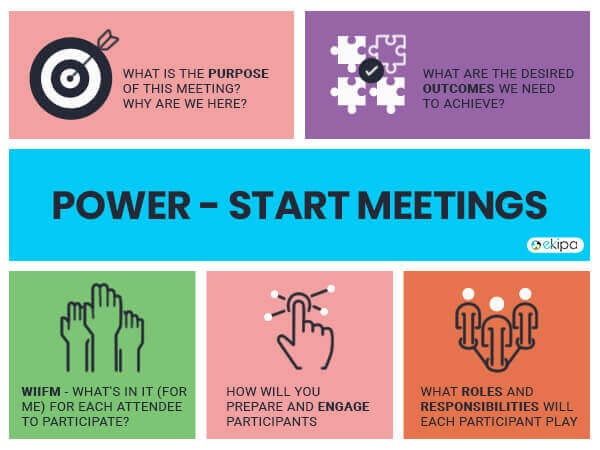We’ve all attended (or led!) ineffective meetings where the purpose is vague or absent.
The meeting owner often jumps straight into the detail, leaving the participants floundering to understand how to contribute or add value.
In the absence of clarity, these meetings are often dominated by the strongest personalities in the room and whatever agenda or opinion they bring to the table.
The POWER Start is a simple and powerful technique that I use to ensure effective meetings when I facilitate.
The POWER Start brings clarity and alignment that ensures the desired outcomes for the meeting are achieved.
The POWER acronym stands for:
- Purpose – What is the overall purpose of the meeting? Why are the participants gathered together for this purpose?
- Outcome – What are the desired outcomes? What will we achieve during our time together?
- What’s in it for them – Why are the invitees invited? What will their participation achieve in service of the purpose and their own needs?
- Engagement – How will you prepare the participants before the meeting? How will you engage and keep them engaged during the session? How will you follow up on what is discussed and agreed?
- Roles & Responsibilities – Who will lead the session? Do you need a timekeeper and someone to capture outputs? What role do you expect your participants to play?

How to use the POWER Start:
- Purpose: Take time to think about the “why” behind the meeting.
Write it down as a single purpose statement. Writing it forces you to be concise and clear.
Make sure it’s not too generic.
E.g. “To get alignment” is too generic. “To review stream plans to understand dependencies” is much clearer.
This clarity ensures you stay focused throughout the meeting.
- Outcome: Bulletpoint all of the outcomes you must achieve by the end of the meeting.
Use this list to structure your agenda and to consider your timings.
I.e. If you have 1 hour together and you must end the meeting with an aligned and committed plan, an open-ended check-in question will take too much time. Structure the agenda to ensure you have time to brainstorm and align on the plan.
- What’s in it for them: Think about each invitee and what value they bring by being present at the meeting. Align this with what value they will receive.
The closer this alignment, the more effective and present each participant will be. Consider if they are essential or if you can pre-align or send them a summary of the outcomes instead.
- Engagement: Now you have your purpose, outcomes and WIIFT – decide how you want to engage the participants before, during and after the meeting so they can be most effective.
Before: Are there any pre-reading or pre-answers to anticipated questions required? Will you send any comms around the agenda, purpose and desired outcomes? What is the most effective time to schedule the meeting based on the participants and the desired outcomes?
During: What energy do you want to foster to get your desired outcome. If the session is to create closer team relationships, consider what check-in question you will ask. Will you need breaks and energisers? Think about how to make the agenda transparent and visual.
After: How will you capture commitments and follow up on actions? Is there any post-session information you will share with the participants and the broader team?
.
- Roles & Responsibilities: List all the tasks that enable a successful meeting. Who will lead facilitation, keep time, and capture actions? Make sure it’s clear who is fulfilling which roles before or at the start of the meeting.
Note: Everyone present will have a role, even as a contributor, reviewer, or advisor.
.
At a minimum, before any meeting, I will take a few minutes to remind myself of the Purpose of the time together and the Outcome(s) we want to achieve by the end of the session.
I will often state this right up front as it helps orient everyone at the start of the meeting. If there are any misaligned meeting expectations, we can quickly discuss and resolve them to be most productive. By orienting upfront, you can return participants to the Purpose and Outcomes if the meeting starts to go off-topic.
Read More Agile Blogs from Ekipa : How do you invite people to engage
Conclusion
The POWER start is a simple way to make your meetings effective, engaging and valuable.
Your meetings will deliver results, with participants leaving feeling accomplished.
As the alignment and clarity of focus increases, teams and departments will require fewer meetings to achieve the same outcome, creating momentum and energy.
Credit: Power Start Technique originally developed by the Agile Coaching Institute.

